ACOM107: Reflection on Cross-Cultural Experience - Australia vs India
VerifiedAdded on 2023/04/12
|7
|1093
|123
Report
AI Summary
This report presents a reflective analysis of cross-cultural experiences, contrasting social customs and attitudes between Australia and India. The author, originally from India and now living in Australia, shares personal observations and reflections on differences in public displays of affection, particularly concerning homosexuality, and the acceptance of diverse relationships. The report highlights the author's initial shock and subsequent inspiration from the openness and equality observed in Australia, contrasted with the more conservative social norms of India. Additionally, the author discusses the differences in community engagement and neighborly relationships, noting the close-knit communities in India compared to the more individualistic lifestyle in Australia. The reflection incorporates personal experiences, research on cultural differences, and concludes with the importance of adapting to different cultural practices for personal and societal well-being. References are provided to support the analysis.
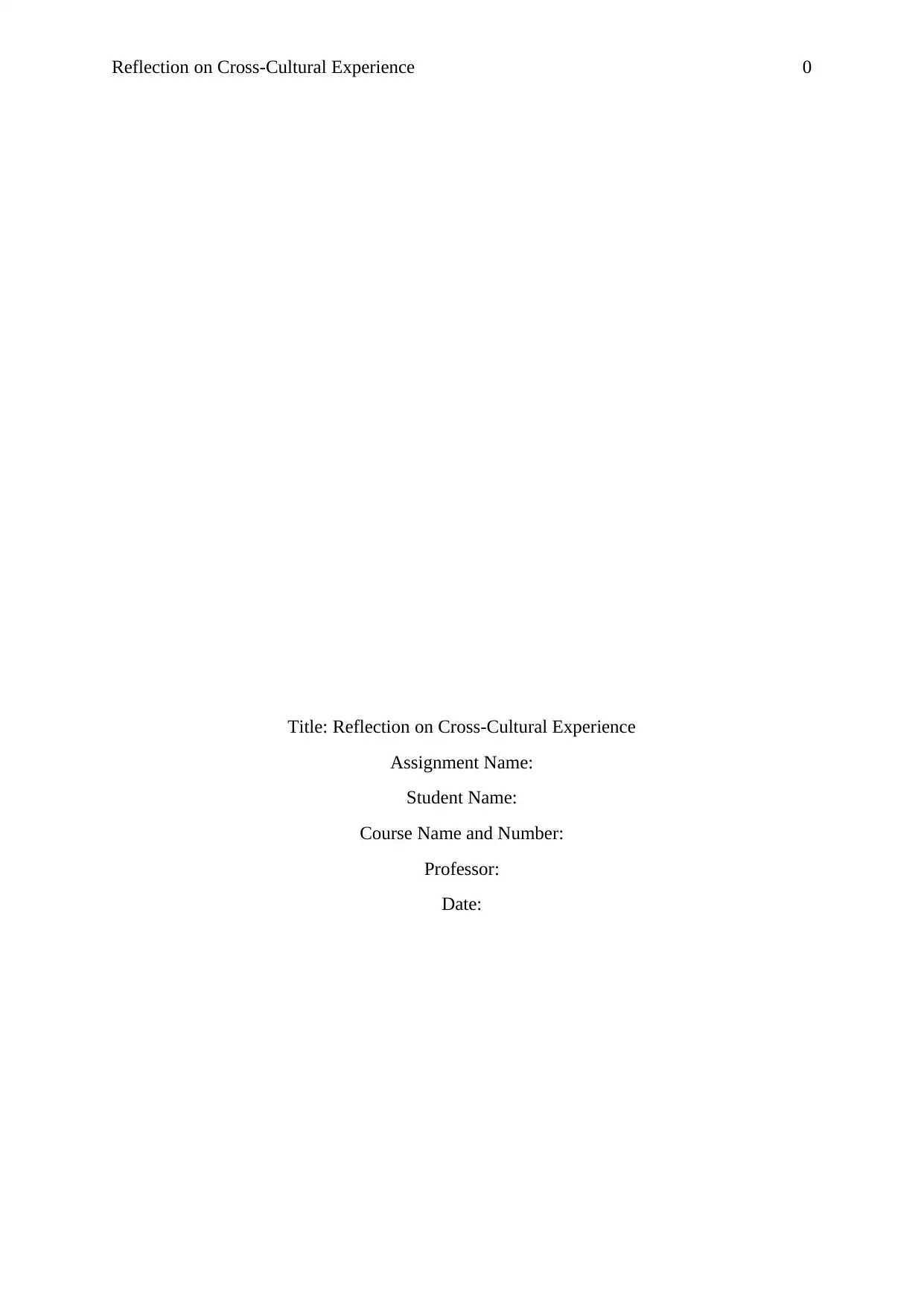
Reflection on Cross-Cultural Experience 0
Title: Reflection on Cross-Cultural Experience
Assignment Name:
Student Name:
Course Name and Number:
Professor:
Date:
Title: Reflection on Cross-Cultural Experience
Assignment Name:
Student Name:
Course Name and Number:
Professor:
Date:
Paraphrase This Document
Need a fresh take? Get an instant paraphrase of this document with our AI Paraphraser

Reflection on Cross-Cultural Experience 1
Contents
Reflective Writing......................................................................................................................2
References..................................................................................................................................5
Contents
Reflective Writing......................................................................................................................2
References..................................................................................................................................5
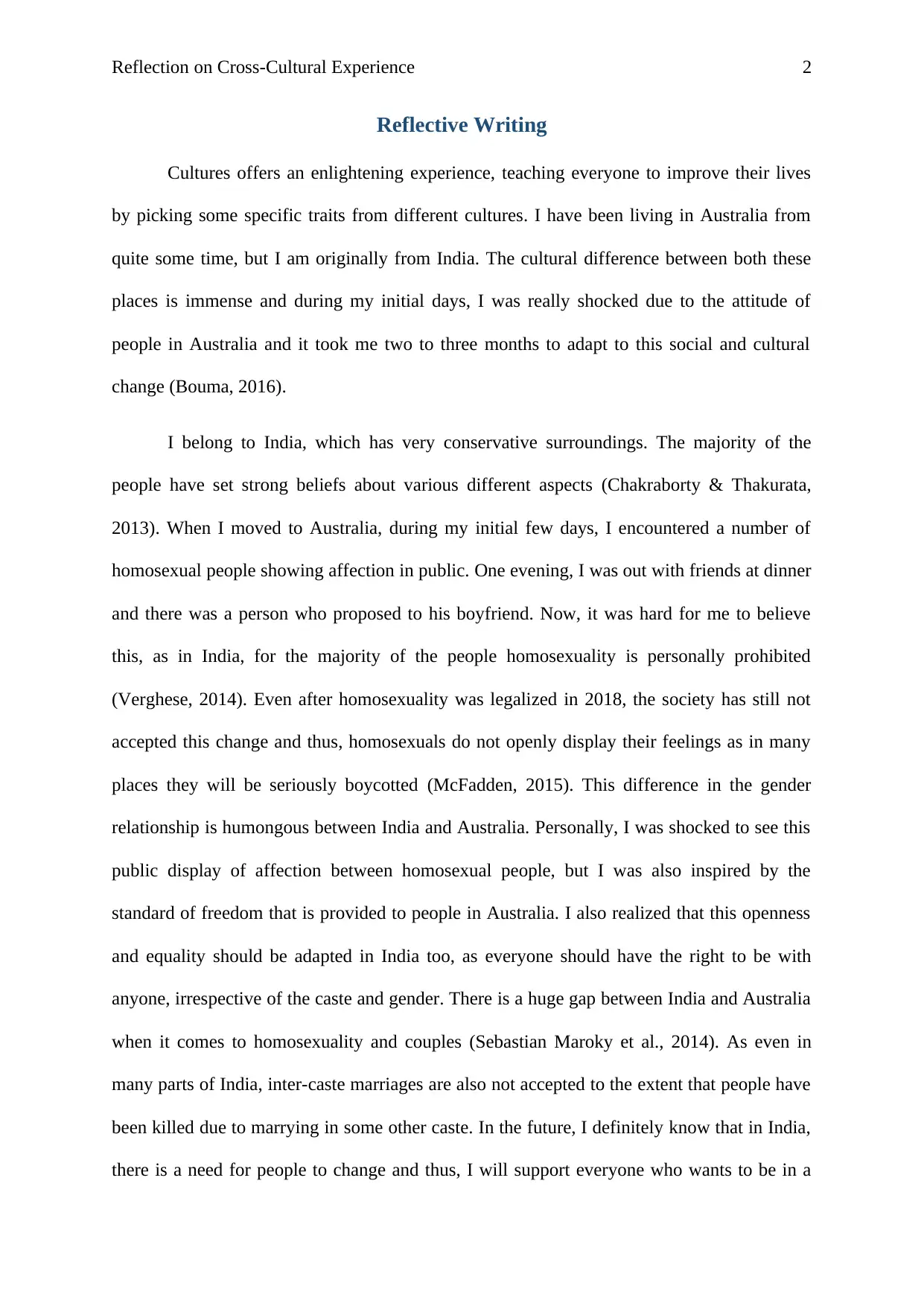
Reflection on Cross-Cultural Experience 2
Reflective Writing
Cultures offers an enlightening experience, teaching everyone to improve their lives
by picking some specific traits from different cultures. I have been living in Australia from
quite some time, but I am originally from India. The cultural difference between both these
places is immense and during my initial days, I was really shocked due to the attitude of
people in Australia and it took me two to three months to adapt to this social and cultural
change (Bouma, 2016).
I belong to India, which has very conservative surroundings. The majority of the
people have set strong beliefs about various different aspects (Chakraborty & Thakurata,
2013). When I moved to Australia, during my initial few days, I encountered a number of
homosexual people showing affection in public. One evening, I was out with friends at dinner
and there was a person who proposed to his boyfriend. Now, it was hard for me to believe
this, as in India, for the majority of the people homosexuality is personally prohibited
(Verghese, 2014). Even after homosexuality was legalized in 2018, the society has still not
accepted this change and thus, homosexuals do not openly display their feelings as in many
places they will be seriously boycotted (McFadden, 2015). This difference in the gender
relationship is humongous between India and Australia. Personally, I was shocked to see this
public display of affection between homosexual people, but I was also inspired by the
standard of freedom that is provided to people in Australia. I also realized that this openness
and equality should be adapted in India too, as everyone should have the right to be with
anyone, irrespective of the caste and gender. There is a huge gap between India and Australia
when it comes to homosexuality and couples (Sebastian Maroky et al., 2014). As even in
many parts of India, inter-caste marriages are also not accepted to the extent that people have
been killed due to marrying in some other caste. In the future, I definitely know that in India,
there is a need for people to change and thus, I will support everyone who wants to be in a
Reflective Writing
Cultures offers an enlightening experience, teaching everyone to improve their lives
by picking some specific traits from different cultures. I have been living in Australia from
quite some time, but I am originally from India. The cultural difference between both these
places is immense and during my initial days, I was really shocked due to the attitude of
people in Australia and it took me two to three months to adapt to this social and cultural
change (Bouma, 2016).
I belong to India, which has very conservative surroundings. The majority of the
people have set strong beliefs about various different aspects (Chakraborty & Thakurata,
2013). When I moved to Australia, during my initial few days, I encountered a number of
homosexual people showing affection in public. One evening, I was out with friends at dinner
and there was a person who proposed to his boyfriend. Now, it was hard for me to believe
this, as in India, for the majority of the people homosexuality is personally prohibited
(Verghese, 2014). Even after homosexuality was legalized in 2018, the society has still not
accepted this change and thus, homosexuals do not openly display their feelings as in many
places they will be seriously boycotted (McFadden, 2015). This difference in the gender
relationship is humongous between India and Australia. Personally, I was shocked to see this
public display of affection between homosexual people, but I was also inspired by the
standard of freedom that is provided to people in Australia. I also realized that this openness
and equality should be adapted in India too, as everyone should have the right to be with
anyone, irrespective of the caste and gender. There is a huge gap between India and Australia
when it comes to homosexuality and couples (Sebastian Maroky et al., 2014). As even in
many parts of India, inter-caste marriages are also not accepted to the extent that people have
been killed due to marrying in some other caste. In the future, I definitely know that in India,
there is a need for people to change and thus, I will support everyone who wants to be in a
⊘ This is a preview!⊘
Do you want full access?
Subscribe today to unlock all pages.

Trusted by 1+ million students worldwide
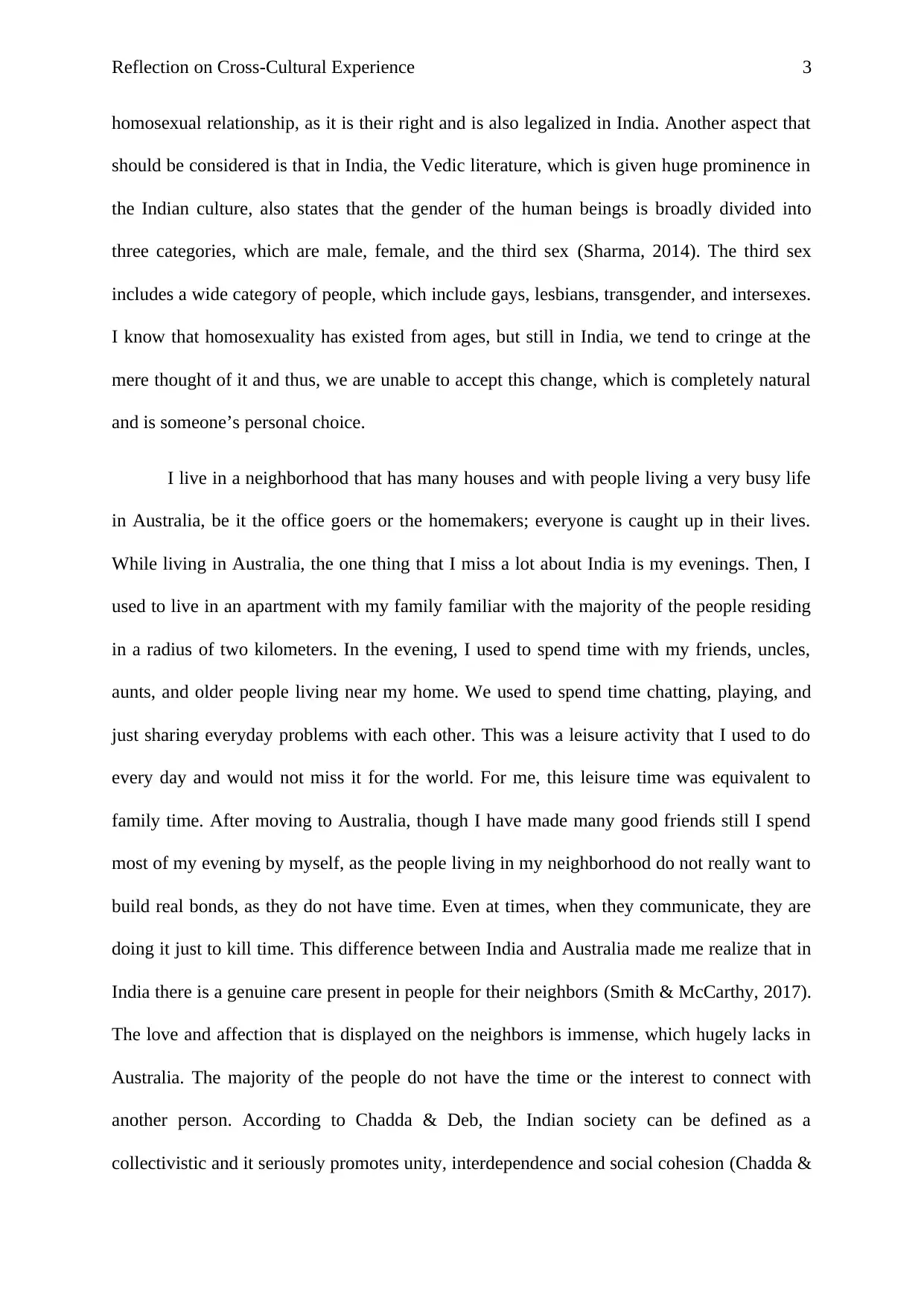
Reflection on Cross-Cultural Experience 3
homosexual relationship, as it is their right and is also legalized in India. Another aspect that
should be considered is that in India, the Vedic literature, which is given huge prominence in
the Indian culture, also states that the gender of the human beings is broadly divided into
three categories, which are male, female, and the third sex (Sharma, 2014). The third sex
includes a wide category of people, which include gays, lesbians, transgender, and intersexes.
I know that homosexuality has existed from ages, but still in India, we tend to cringe at the
mere thought of it and thus, we are unable to accept this change, which is completely natural
and is someone’s personal choice.
I live in a neighborhood that has many houses and with people living a very busy life
in Australia, be it the office goers or the homemakers; everyone is caught up in their lives.
While living in Australia, the one thing that I miss a lot about India is my evenings. Then, I
used to live in an apartment with my family familiar with the majority of the people residing
in a radius of two kilometers. In the evening, I used to spend time with my friends, uncles,
aunts, and older people living near my home. We used to spend time chatting, playing, and
just sharing everyday problems with each other. This was a leisure activity that I used to do
every day and would not miss it for the world. For me, this leisure time was equivalent to
family time. After moving to Australia, though I have made many good friends still I spend
most of my evening by myself, as the people living in my neighborhood do not really want to
build real bonds, as they do not have time. Even at times, when they communicate, they are
doing it just to kill time. This difference between India and Australia made me realize that in
India there is a genuine care present in people for their neighbors (Smith & McCarthy, 2017).
The love and affection that is displayed on the neighbors is immense, which hugely lacks in
Australia. The majority of the people do not have the time or the interest to connect with
another person. According to Chadda & Deb, the Indian society can be defined as a
collectivistic and it seriously promotes unity, interdependence and social cohesion (Chadda &
homosexual relationship, as it is their right and is also legalized in India. Another aspect that
should be considered is that in India, the Vedic literature, which is given huge prominence in
the Indian culture, also states that the gender of the human beings is broadly divided into
three categories, which are male, female, and the third sex (Sharma, 2014). The third sex
includes a wide category of people, which include gays, lesbians, transgender, and intersexes.
I know that homosexuality has existed from ages, but still in India, we tend to cringe at the
mere thought of it and thus, we are unable to accept this change, which is completely natural
and is someone’s personal choice.
I live in a neighborhood that has many houses and with people living a very busy life
in Australia, be it the office goers or the homemakers; everyone is caught up in their lives.
While living in Australia, the one thing that I miss a lot about India is my evenings. Then, I
used to live in an apartment with my family familiar with the majority of the people residing
in a radius of two kilometers. In the evening, I used to spend time with my friends, uncles,
aunts, and older people living near my home. We used to spend time chatting, playing, and
just sharing everyday problems with each other. This was a leisure activity that I used to do
every day and would not miss it for the world. For me, this leisure time was equivalent to
family time. After moving to Australia, though I have made many good friends still I spend
most of my evening by myself, as the people living in my neighborhood do not really want to
build real bonds, as they do not have time. Even at times, when they communicate, they are
doing it just to kill time. This difference between India and Australia made me realize that in
India there is a genuine care present in people for their neighbors (Smith & McCarthy, 2017).
The love and affection that is displayed on the neighbors is immense, which hugely lacks in
Australia. The majority of the people do not have the time or the interest to connect with
another person. According to Chadda & Deb, the Indian society can be defined as a
collectivistic and it seriously promotes unity, interdependence and social cohesion (Chadda &
Paraphrase This Document
Need a fresh take? Get an instant paraphrase of this document with our AI Paraphraser
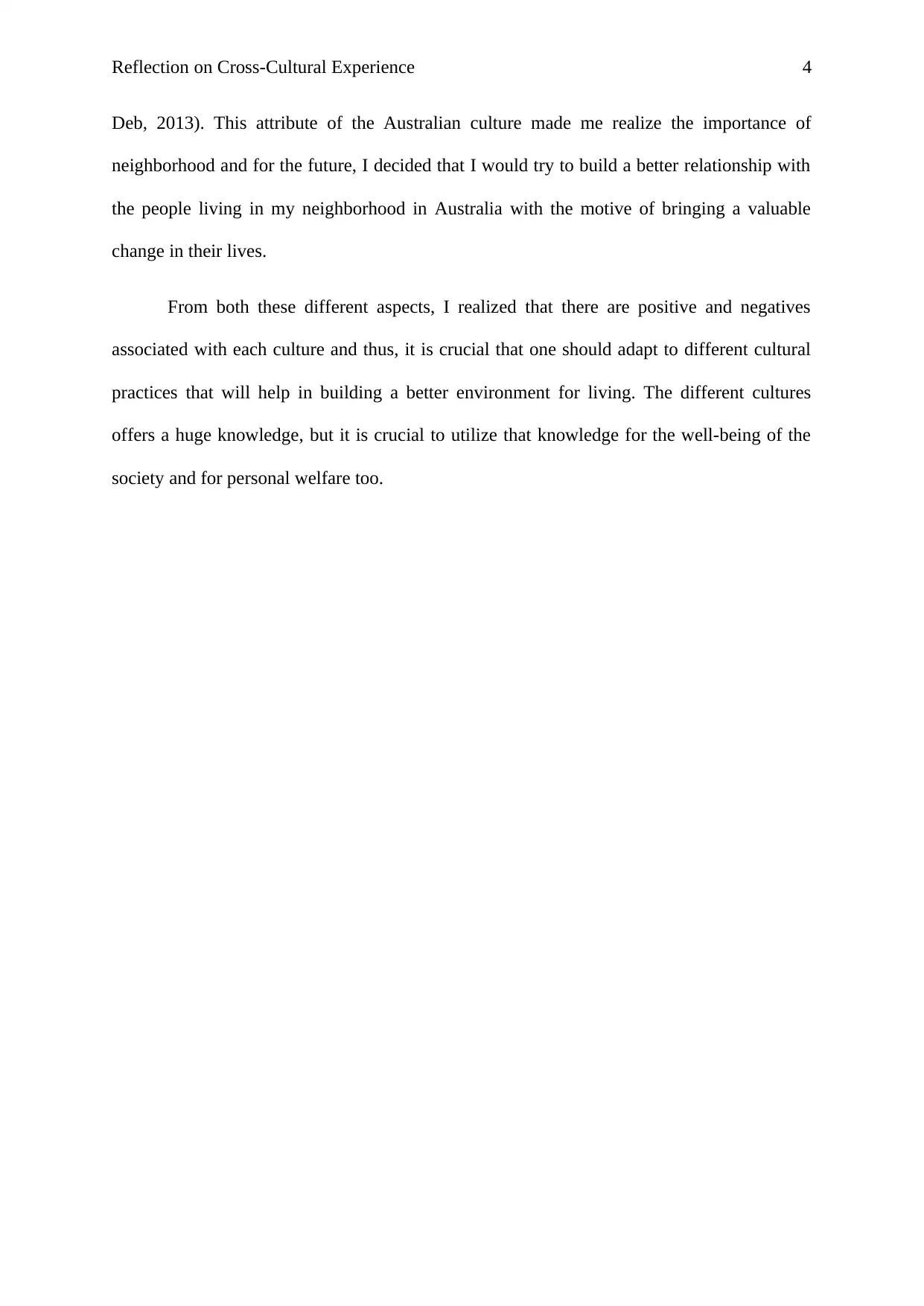
Reflection on Cross-Cultural Experience 4
Deb, 2013). This attribute of the Australian culture made me realize the importance of
neighborhood and for the future, I decided that I would try to build a better relationship with
the people living in my neighborhood in Australia with the motive of bringing a valuable
change in their lives.
From both these different aspects, I realized that there are positive and negatives
associated with each culture and thus, it is crucial that one should adapt to different cultural
practices that will help in building a better environment for living. The different cultures
offers a huge knowledge, but it is crucial to utilize that knowledge for the well-being of the
society and for personal welfare too.
Deb, 2013). This attribute of the Australian culture made me realize the importance of
neighborhood and for the future, I decided that I would try to build a better relationship with
the people living in my neighborhood in Australia with the motive of bringing a valuable
change in their lives.
From both these different aspects, I realized that there are positive and negatives
associated with each culture and thus, it is crucial that one should adapt to different cultural
practices that will help in building a better environment for living. The different cultures
offers a huge knowledge, but it is crucial to utilize that knowledge for the well-being of the
society and for personal welfare too.
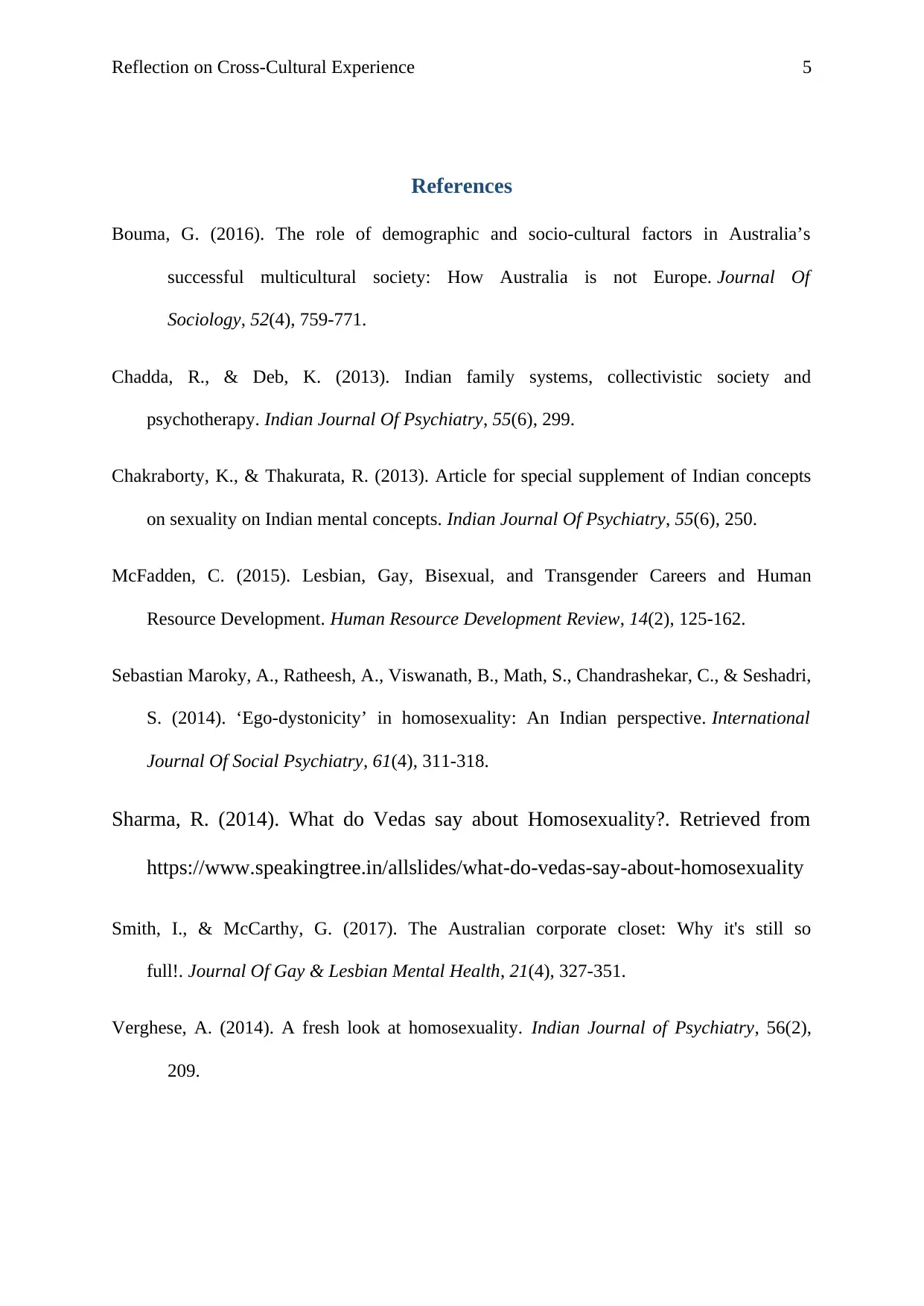
Reflection on Cross-Cultural Experience 5
References
Bouma, G. (2016). The role of demographic and socio-cultural factors in Australia’s
successful multicultural society: How Australia is not Europe. Journal Of
Sociology, 52(4), 759-771.
Chadda, R., & Deb, K. (2013). Indian family systems, collectivistic society and
psychotherapy. Indian Journal Of Psychiatry, 55(6), 299.
Chakraborty, K., & Thakurata, R. (2013). Article for special supplement of Indian concepts
on sexuality on Indian mental concepts. Indian Journal Of Psychiatry, 55(6), 250.
McFadden, C. (2015). Lesbian, Gay, Bisexual, and Transgender Careers and Human
Resource Development. Human Resource Development Review, 14(2), 125-162.
Sebastian Maroky, A., Ratheesh, A., Viswanath, B., Math, S., Chandrashekar, C., & Seshadri,
S. (2014). ‘Ego-dystonicity’ in homosexuality: An Indian perspective. International
Journal Of Social Psychiatry, 61(4), 311-318.
Sharma, R. (2014). What do Vedas say about Homosexuality?. Retrieved from
https://www.speakingtree.in/allslides/what-do-vedas-say-about-homosexuality
Smith, I., & McCarthy, G. (2017). The Australian corporate closet: Why it's still so
full!. Journal Of Gay & Lesbian Mental Health, 21(4), 327-351.
Verghese, A. (2014). A fresh look at homosexuality. Indian Journal of Psychiatry, 56(2),
209.
References
Bouma, G. (2016). The role of demographic and socio-cultural factors in Australia’s
successful multicultural society: How Australia is not Europe. Journal Of
Sociology, 52(4), 759-771.
Chadda, R., & Deb, K. (2013). Indian family systems, collectivistic society and
psychotherapy. Indian Journal Of Psychiatry, 55(6), 299.
Chakraborty, K., & Thakurata, R. (2013). Article for special supplement of Indian concepts
on sexuality on Indian mental concepts. Indian Journal Of Psychiatry, 55(6), 250.
McFadden, C. (2015). Lesbian, Gay, Bisexual, and Transgender Careers and Human
Resource Development. Human Resource Development Review, 14(2), 125-162.
Sebastian Maroky, A., Ratheesh, A., Viswanath, B., Math, S., Chandrashekar, C., & Seshadri,
S. (2014). ‘Ego-dystonicity’ in homosexuality: An Indian perspective. International
Journal Of Social Psychiatry, 61(4), 311-318.
Sharma, R. (2014). What do Vedas say about Homosexuality?. Retrieved from
https://www.speakingtree.in/allslides/what-do-vedas-say-about-homosexuality
Smith, I., & McCarthy, G. (2017). The Australian corporate closet: Why it's still so
full!. Journal Of Gay & Lesbian Mental Health, 21(4), 327-351.
Verghese, A. (2014). A fresh look at homosexuality. Indian Journal of Psychiatry, 56(2),
209.
⊘ This is a preview!⊘
Do you want full access?
Subscribe today to unlock all pages.

Trusted by 1+ million students worldwide

Reflection on Cross-Cultural Experience 6
1 out of 7
Your All-in-One AI-Powered Toolkit for Academic Success.
+13062052269
info@desklib.com
Available 24*7 on WhatsApp / Email
![[object Object]](/_next/static/media/star-bottom.7253800d.svg)
Unlock your academic potential
Copyright © 2020–2025 A2Z Services. All Rights Reserved. Developed and managed by ZUCOL.
